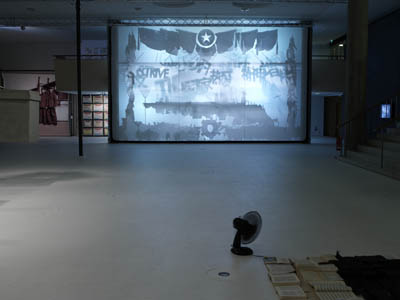QIU ZHIJIE: TWILIGHT OF THE IDOLS
| February 1, 2010 | Post In LEAP 1

The fourth installment in an ongoing series of shows on the “suicidology of the Nanjing Yangtze River Bridge,” Qiu Zhijie’s recent Berlin outing presented a set of problems and questions distinct from its two predecessors. For Qiu, the Nanjing Bridge is the one great symbol of China’s utopian socialism and its dystopian aftermath: a dream of material progress made manifest in infrastructure before it had actually been achieved, then shattered into a suicide venue as life in the People’s Republic grew richer and more complicated. Qiu’s practice has long sought out this kind of metaphorical site and subjected it to social research. In the Nanjing Bridge he seems to have found enough meat—symbolic, narrative, visual, historical—to sustain his voracious appetite for at least a few more years.
In all four showss, the basic tension has been between pieces that do archival work, compiling and classifying objects à la Broodthaers, and pieces that attempt to transfigure objects as symbols into objects as totems à la Beuys (whence this exhibition’s title). The tension between these two approaches is sometimes palpable, as the singular object is rarely the object of Qiu’s attention, nor the place where he wishes to direct his viewer’s. Witness the oft-heard critique of “Breaking Through the Ice,” his show at Beijing’s Ullens Center for Contemporary Art early last year, which revolved around scale: it was seen as too big and too spectacular to be serious. But the problem was actually that there was simply too much “stuff” for any of it to mean much. Nearly thirty installations collided into a fallout zone of floating signifiers, lying just beyond the boundaries of our apperception in a future place where our grasp of Mandarin (even for those of us who grasp Mandarin) and “traditional Chinese culture” are just a bit more practiced.
In Berlin, Qiu erred on the opposite side, narrating the nation (or nations, as a number of works seemed as concerned with Germany as China) with a series of works that came off as neither coy nor particularly monumental. A floor of inky old books greeted viewers, occupying the floor space next to a line of stucco cubes (bridge pilings?) hanging like ski lift cars from an overhead cable, each with a pair of boots atop it (Who Are the Happiest People in the World?, 2009). Leaning against the curtain wall was a line of two-dimensional mirror cutouts of German birds, a localized reference to those who nest on the bridge; black outlines of the shadows cast by fifteen states of notable Germans found around Berlin were pasted on the windows, each blown up to 190 by 550 cm (The Cryptical Rovers, 2009). Off to one side, a screen appeared to mimic an oversized award certificate bearing the image of the bridge (Diploma IV, 2009); from behind, the viewer sees that the shadowy likeness is actually achieved through an assemblage of junk, a trick not unlike that played by Xu Bing in his recent Background Story installations. Up on a mezzanine, a wall of actual certificates employing this iconography provided a direct referent for the explorations below.
As interesting as it is for close observers to watch the prolific Qiu modulate his register away from grand, ink-painting-heavy gestures—and, for Chinese contemporary fans, to see him go solo in the European institution that mounted the continent’s first major “China show” with “China Avant-Garde” in 1993—one is left wanting something a bit more but unsure exactly what that might be. Philip Tinari

